GPD
GPD Pocket: the 7 inch laptop
Aprox. 609€ - see price -
See specificationsIs it a tablet? Is it a laptop? Is it a good old pocket PC, like we found in the early 2000s? One thing is certain: GPD Pocket leaves no one indifferent. The Chinese manufacturer, to whom we also owe the portable console under Windows 10 GPD Win, has raised more than 3.5 million dollars on Indigogo to finance the Pocket, which could be summarized as follows: the design of a MacBook Pro in 7 inch format, all under Windows 10.
Our review
Presentation
First of all, it should be noted that the GPD Pocket is an imported product and is therefore not officially available in Spain. As such, we thank Gearbest for the loan of the product, the merchant site selling the device € 426.48 (excluding taxes and customs fees).
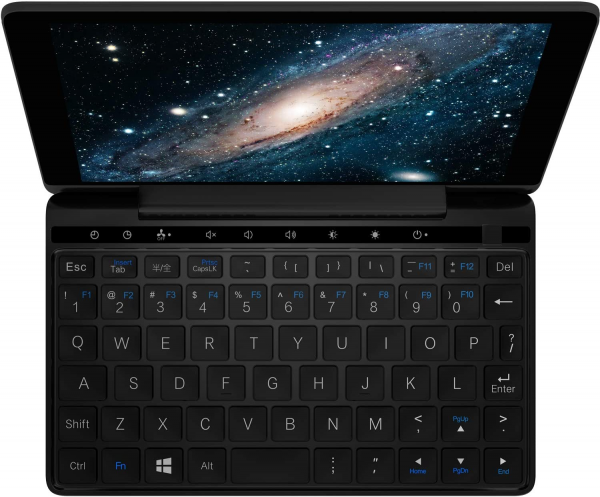
Construction
What a strange object this GPD Pocket! At first glance, we have the tenacious impression of being in front of a MacBook Pro that would have been washed, as the design and the materials used evoke Apple's notebook. The inspiration is obvious, but the result is successful. The Chinese manufacturer has indeed made every effort to give a "premium" look to its product: chassis entirely in aluminum, solid hinge system, keyboard which occupies the entire length, very high level of finish ... In hand, the product convinces by its manufacturing quality and the impression of solidity which it gives off.
But the GPD Pocket is not just a pretty "miniature" laptop: it aims to be as functional as possible. To achieve this, the Chinese company has implemented a real QWERTY keyboard which is fairly well optimized and has a blue touch button serving as a pointer. Reduced format requires, there is no touchpad; it is therefore necessary to alternate between a purely tactile use on the screen and manipulation of the small blue button. The latter is fairly well placed and allows you to naturally keep your hands on the keyboard. On the other hand, it will be necessary to pass in the options of Windows 10 to modify its sensitivity, because that by default is very weak. Once the correct settings are applied, the cursor becomes fast and precise.
But what interests us especially here is the quality of the keyboard and its practicality in everyday life. GPD has done the best possible integration work, since the keyboard occupies the entire width of the chassis. The keys are fairly well spaced and the race is long. The slightly "brushed" touch is also very pleasant. However, we must admit that its daily use is far from simple. Despite all the efforts, the keys remain small and it is very difficult to type quickly and with all your fingers without making huge shells. It will quickly be necessary to use only its two indexes and thumbs for the space bar, or else grab the laptop with both hands and type with your thumbs, like on a tablet or smartphone. In any case, writing sessions that are a bit long and intensive are to be avoided, unless you have tiny fingers.
Despite its small size, the GPD Pocket offers fairly complete connectivity, GPD having had at heart to keep a certain chassis thickness (between 7 and 10 mm), which allows to wedge a USB 3 Type-A port, a micro port -HDMI, a jack and a USB 3 Type-C port (also used for charging). Bluetooth 4.1 and Wi-Fi a / ac / b / gn connectivity is also part of the game.
The GPD Pocket has a hot air exhaust system on the right side, which allows it to keep a decent temperature. After an hour of stress test under Unigine Heaven, we find a hot spot at 40.5 ° C at the bottom of the keyboard; the rest remains below 38.4 ° C. A slight breath is heard during light use. It remains very discreet and well below the 37 dB generally observed in a living room.
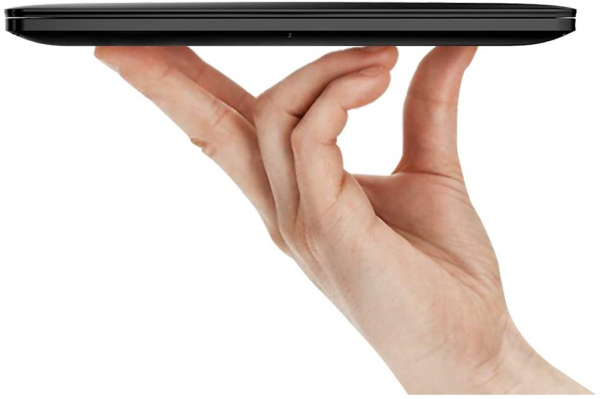
Screen
The GPD Pocket has a 7 inch IPS touch screen, displaying a resolution of 1,920 x 1,200 px in 16:10 format. At first glance, GPD seems to have worked well on this aspect of the product, and there is an image that is well developed, in a fairly comfortable format.
The figures recorded with our probe, however, qualify this first good impression. The screen of the GPD Pocket is thus in a small average for a laptop, and is largely exceeded by most of the tablets on the market. The maximum brightness rises to 272 cd / m² and the contrast ratio reaches 780: 1. Readability remains good despite everything.
delta color E = 5.1 gamma 2.2 temperature 7950 K
In terms of colorimetry, here again, the GPD Pocket is a student that we would have liked more applied. Delta E is 5.1 (remember that it represents the difference between the actual colors and the colors displayed, and that it is considered to be very good below 3). The color temperature reaches 7,950 K - here, the closer you get to 6,500 K, the better the balance between warm and cool tones. In the case of the GPD Pocket, there is therefore a fairly straightforward drift towards the cold shades. The gamma curve, on the other hand, is particularly stable, indicating a well-defined gray gradient. Finally, there is a remanence of 22 ms, which remains quite bad, even for IPS.
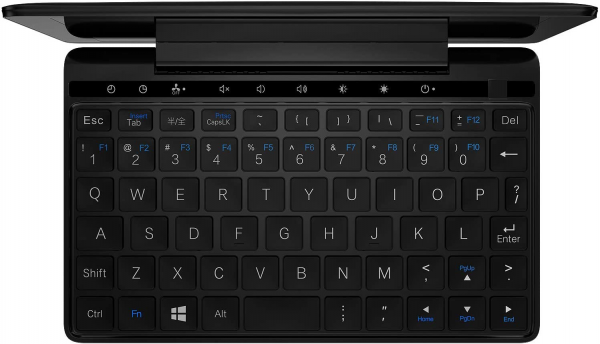
Performances
The Pocket GPD is equipped with an Intel Atom x7-Z8750 processor, accompanied by 8 GB of RAM and 128 GB of storage in eMMC format (manufactured by Samsung). This very low-power CPU is usually found in entry-level ultraportable PCs, or in the GPD Win from the same manufacturer. The presence of 8 GB of RAM and 128 GB of storage space are however a real plus.
In practice, the GPD Pocket is certainly not a thunderbolt of velocity, but offers a sufficient level of performance in the context of a use limited to office automation, surfing on the web or watching videos. And that's good, since that's exactly what it is for. Due to its format, the use that you can make of it is in any case restricted. GPD has therefore made judicious choices on this point, favoring in particular the presence of 8 GB of RAM and storage in the form of 128 GB eMMC.
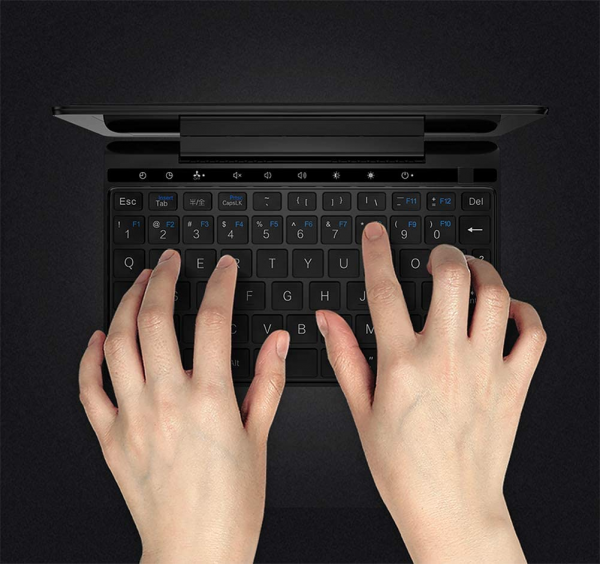
Games
Of course, no miracle here: the graphics part of the Pocket GPD runs on the iGPU Intel HD Graphics 405. A graphics chip quite incapable of running recent games in 3D and we must limit ourselves to pure 2D, or really very old titles. That said, a service like Steam is full of independent games using pixel art, which will adapt very well to this configuration. Pair a small Bluetooth controller, and voila.
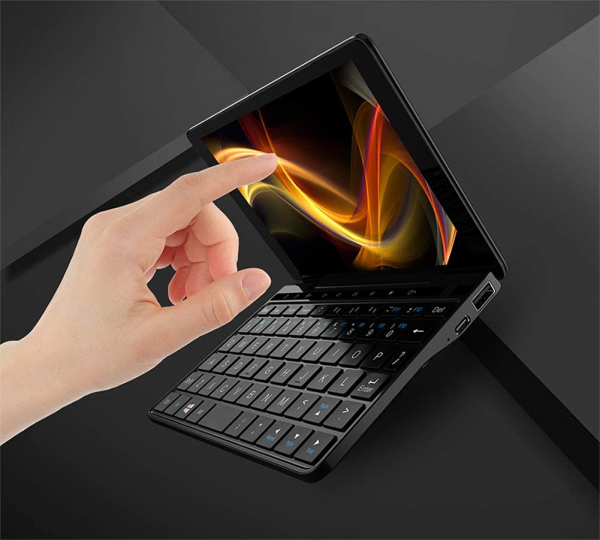
Mobility / Autonomy
In terms of transportability, the GPD Pocket is obviously an excellent student. With its 18 cm long, 10.6 cm wide, 1.8 cm thick and 480 g, it easily fits in a very small bag, an inside coat pocket, or even a pants pocket. Its format is certainly its big highlight.
On the autonomy side, the results are a little more mixed. GPD announces up to 12 hours of use, which seems somewhat exaggerated. In practice, our streaming video playback test (Netflix in Chrome, brightness at 200 cd / m², headphones plugged in) ran for 5 hours 17 minutes. A very average score, which is however not entirely representative of office use. By playing on the brightness and energy saving, it is possible to use the GPD Pocket for 6 to 8 hours. We are still far from the 12 hours announced by the manufacturer.
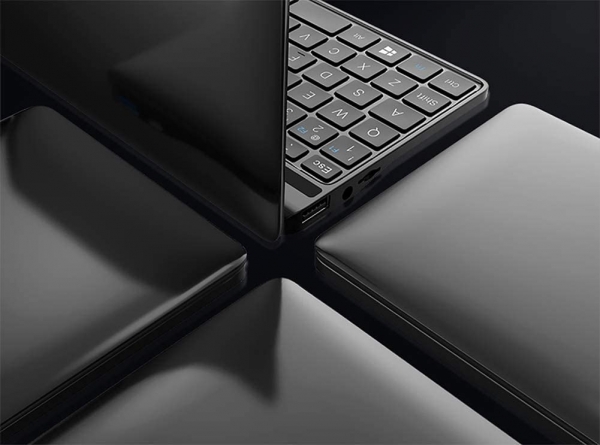
Audio
The GPD Pocket's headphone output is of average quality. The distortion rate is low (0.03%), but the output power, although sufficient, remains quite limited. The entire sound spectrum is well rendered.
The single speaker, on the other hand, delivers a very poor sound with limited power. Absence of bass and treble, some mids ... The whole sound hollow and metallic. It is clearly not the best aspect of the product.
Conclusion
Difficult to note the GPD Pocket, as the product combines the qualities, but remains limited in its uses. GPD has managed to create a real "mini" laptop in 7 inch format, particularly well constructed and thought out. You should however be aware that its extreme compactness does not allow it to be as versatile as an ultraportable and that its keyboard, as intelligently designed as it is, remains difficult to use. A good niche product, which you should buy with full knowledge of the facts.
Specifications
Reviews

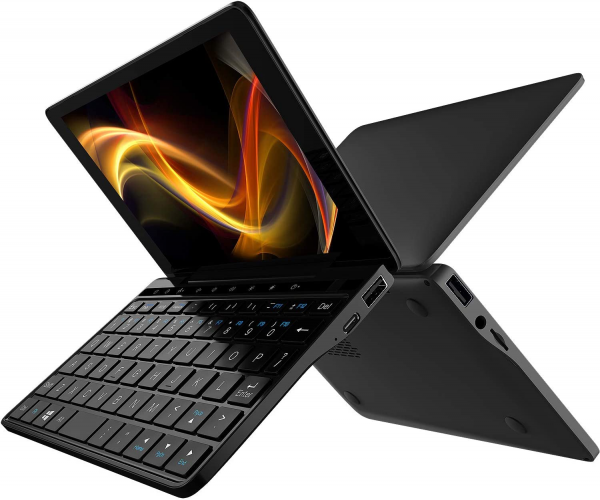
Bricked because of battery after 4 months
I really did like this little compact thing ... when it worked. It is sleek, compact, feels well built. Win10 on the screen can be a bit hard to read depending on what your are dealing with. I put photoshop on it and it worked well, even though it was hard to see details.
But .... last week I started getting the "Plugged in, but not charging." error. After extensive searching on the web I found this is not an uncommon problem with several different models. Seems to be related to Win 10.
Nonetheless I tried all the various fixes I could find with no luck. Even completely reset the computer with Win 10. Ultimately I got through on a chat with a KendyZ of Shenzin in Hong Kong. Not helpful at all. Kept saying over and over that since I bought it from Amazon, I had to contact them. It was past the 30 day return period at this point. KendyZ provided no support at all. Eventually suggested I could send it back to them in Hong Kong! (Which would require removing the LiPo battery and shipping expense, and who knows how much time!) S / he would not honor the stated one-year warranty.
Because of the battery failure after only 4 months and the extremely poor support from Shenzin, I cannot recommend buying this. I have to say that I really liked it when it was working, but it is a very chancy purchase at $ 600. After 30 days you are on your own. No return. No warranty. Possibly no working PC.
Best camping laptop ever
I bought this for camping and I absolutely love it. It recharges via a 5V USB so any solar charger with USB will work to recharge it. I can't comment on Windows 10 performance as I immediately put Linux on it but Ubuntu works flawlessly and boots up in around ten seconds give or take. It fits perfectly in my pocket too so that's a huge bonus for someone who travels a lot. The battery life is very good for a laptop. Ranging from three hours if you are gaming to 10 hours for watching youtube videos. Some people have complained that the fan is "noisy" but even when it's running hot, I barely hear it.
I'm usually pretty picky about electronics but I don't really have any complaints on this one. There are two things that would have been nice to have but given the size of the laptop, I understand why it's that way. It feels very well built and reminds me of the old Nintendo-Quality of handhelds that felt pretty indestructible in your hands.
It has no speakers so you have to use headphones if you want audio. Given the small size of the laptop, you couldn't feasibly put decent quality speakers on it so perhaps that's for the best. The keyboard layout is squished to fit the laptop size so it takes a little while to get used to where all the special symbols are on the keyboard.
Dont buy it
Bought this three months ago. I work in the hospital and find it useful to have a tiny windows capable machine to put in my backpack. Anyway just yesterday I was trying to fix the super tight hinge mechanism (it was nearly impossible to open from the closed position). anyway one of the screw holes got stripped simply by removing the screw and also the screen doesnt turn on anymore. I will take responsibility for the screen not working even though i was extremely careful. I'm pretty comfortable taking apart electronics. but what i came here to say is that the product quality is very poor considering i couldnt screw all the screws back in after opening it once. and also the hinge mechanism is a joke. its not adjustable and frankly bound to loosen over time. You really do get what you pay for. 600 dollars plus overpriced leather case down the toilet. Save your money for something else that isnt China made.
Colors don't match the pictures. Not a super powerful computer but very portable.
I would give this a 5 star review if it wasn't for me being upset about it being Gray and. Not black like I wanted and ordered. And for the fact that the ram isn't replaceable but I guess replaceable ram Might add thickness to the device. But you can replace everything else. It's a great little computer is it worth $ 500 well are you needing to sneak a full computer into a buisness to hack it but they don't allow personal laptops inside the building and you have pockets in your pants so you can hide the pc and it can run off of a phone charger or you want a computer that's super portable that can run everything your regular laptop can do? Or play some retro games. This this pc is for you! It won't play games like are 4k or whatever but you can play psp games or ds games on it
Real machine in pocket size
Very solid Windows machine, which I use for number crunching of gigabyte datasets in R and a bunch of spreadsheets. Most of the reviews about issues with power, bios etc are out of date - everything work fine out of the box. Optical mouse button works very well when you get used to it, and it is accompanied by right and left click buttons on the top panel. If you are not a touch typist the keyboard is just a fast aa regular one, and the keys have a good action. Whether you are comfortable looking at an HD res screen in 7 inches is up to you. I'm short sighted so it is perfectly fine. Goes with me wherever I go, and is built like a (light) tank!
This is a Small PC!!
I had decided to downgrade the backpack I carry for work to a small shoulder bag. However I still need a PC since i handle on call IT for a Medical Center, and need something that will fit the bag, since my Surface is a bit to big for the bag.
Also something that is a bit more powerful and has more RAM and Disk space than a Windows tablet.
This thing is small !! it fits in my pocket, and powerful.
Best little computer!!!
What an amazing little computer! Definitely what I was looking for. I use it for on the go ... mostly writing documents and going on the internet. Nothing heavy duty.
Arrived DOA
I was pretty excited for this, but it arrived DOA. I'm glad I bought it from Amazon and don't have to be worried about returning it.